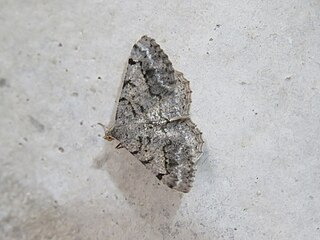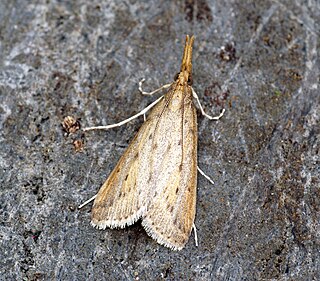
Frederickia is a genus of moths in the family Geometridae described by Alexander Douglas Campbell Ferguson in 2008.
Chlorobaptella is a monotypic moth genus of the family Crambidae erected by Eugene G. Munroe in 1995. Its only species, Chlorobaptella rufistrigalis, was first described by William Barnes and James Halliday McDunnough in 1914. It is found in North America, where it has been recorded from California and Nevada. Moths in this genus are distinguished from moths in similar genera by their small palpi and obsolete tongues.
Leptosteges is a genus of moths of the family Crambidae.
Coenochroa bipunctella, the sand dune panic grass moth, is a species of snout moth in the genus Coenochroa. It was described by William Barnes and James Halliday McDunnough in 1913, and is known from the United States, including Florida, Arizona and Maryland.
Macrorrhinia parvulella is a species of snout moth in the genus Macrorrhinia. It was described by William Barnes and James Halliday McDunnough in 1913 and is known from the US states of Florida and South Carolina. It is also found in Colombia.
Negalasa is a monotypic snout moth genus. Its one species, Negalasa fumalis, is found in the US state of Arizona. Both the genus and species were described by William Barnes and James Halliday McDunnough in 1913 in the same paper.
Crambidia pura, the pure lichen moth, is a moth of the family Erebidae. It was described by William Barnes and James Halliday McDunnough in 1913. It is found in North America, including Arizona, Florida, Georgia, Kentucky, Maryland, Mississippi, New Jersey, North Carolina, Ohio, Ontario, South Carolina, Tennessee, Texas and Wisconsin.
Cisthene conjuncta, the white-streaked lichen moth, is a moth of the family Erebidae. It was described by William Barnes and James Halliday McDunnough in 1913. It is found in southern Texas.
Cisthene subrufa, the Tamaulipan lichen moth, is a moth of the family Erebidae. It was described by William Barnes and James Halliday McDunnough in 1913. It is found in the United States in Arizona and from San Benito, Texas south to Veracruz in Mexico.

Schoenobiinae is a subfamily of the lepidopteran family Crambidae. The subfamily was described by Philogène Auguste Joseph Duponchel in 1846.
Thaumatopsis floridella, the Floridian grass-veneer, is a moth in the family Crambidae. It was described by William Barnes and James Halliday McDunnough in 1913. It is found in North America, where it has been recorded from coastal areas in Florida, Georgia, Mississippi, South Carolina and North Carolina, New Jersey, New York, and Rhode Island. It is also found in Cuba.
Microcausta flavipunctalis is a moth in the family Crambidae. It was described by William Barnes and James Halliday McDunnough in 1913. It is found in North America, where it has been recorded from Florida. It is also present in Cuba and Puerto Rico.
Xubida chiloidellus is a moth in the family Crambidae. It was described by William Barnes and James Halliday McDunnough in 1913. It is found in North America, where it has been recorded from Arizona.
Xubida dentilineatella is a moth in the family Crambidae. It was described by William Barnes and James Halliday McDunnough in 1913. It is found in Mexico and the southern United States, where it has been recorded from Arizona.
Xubida punctilineella is a moth in the family Crambidae. It was described by William Barnes and James Halliday McDunnough in 1913. It is found in North America, where it has been recorded from Florida.
Loxostege floridalis, the Christmas-berry webworm moth, is a moth in the family Crambidae. It was described by William Barnes and James Halliday McDunnough in 1913. It is found in North America, where it has been recorded from Florida and Texas.
Leptosteges sordidalis is a moth in the family Crambidae. It was described by William Barnes and James Halliday McDunnough in 1913. It is found in North America, where it has been recorded from Florida, Ohio, South Carolina and Ontario.
Atomopteryx solanalis, the carabid moth, is a moth in the family Crambidae. It is found in North America, where it has been recorded from Florida. The species was first described by William Barnes and James Halliday McDunnough in 1913.
Penestola simplicialis is a moth in the family Crambidae. It was described by William Barnes and James Halliday McDunnough in 1913. It is found in Cuba and in the US state of Florida.
Sericosema immaculata is a moth in the family Geometridae described by William Barnes and James Halliday McDunnough in 1913. It is found in North America.

